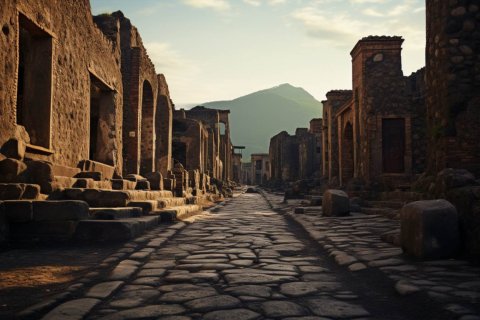Discover Pompeii, Herculaneum, and Majestic Mount Vesuvius from Naples
Embark on an enthralling journey that transports you through time, from the ancient Roman towns of Pompeii and Herculaneum to the summit of the iconic Mount Vesuvius, all in a single day.
Travel back in time as you explore Pompeii, a captivating archaeological site where you can wander amidst the mesmerizing ruins for about 3 hours. Next, venture to Herculaneum and immerse yourself in its history during approximately 2 hours of free exploration.
The apex of your adventure awaits at the summit of Mount Vesuvius, where you'll have 1 hour to wander and absorb the breathtaking panoramic views. Marvel at the remnants of a civilization frozen in time and gain insights into the lives and customs of ancient Romans.
What's Included
Your experience encompasses:
- Round-trip transportation
- Engaging live commentary during the journey
- Free exploration time at each site
- Guided assistance throughout
- Entrance tickets to Pompeii, Herculaneum, and Vesuvius
- A delightful lunch
Choose from Italian, English, or Spanish for a personalized experience and join a small group of no more than 8 participants for an intimate exploration.
Important Information
For a comfortable exploration, remember to wear comfortable shoes and attire to make the most of this adventure into history.
Your journey awaits, offering an enriching blend of ancient wonders and natural beauty.
Uncovering the Mysteries of Pompeii, Mt. Vesuvius: The Majestic Volcano
Pompeii and Mount Vesuvius, two names forever intertwined in the annals of history, stand as silent witnesses to the catastrophic event that unfolded on that fateful day in 79 AD. The ancient city of Pompeii and the formidable volcano, Mount Vesuvius, share a tragic yet enthralling tale.
The city of Pompeii was once a bustling Roman city located near modern-day Naples, Italy. It thrived as a vibrant commercial hub and a center of culture and civilization. However, its fate took a grim turn when Mount Vesuvius, a majestic volcano overlooking the Bay of Naples, erupted in one of the most infamous volcanic eruptions in history.
The eruption of Mount Vesuvius in 79 AD was a cataclysmic event that engulfed Pompeii in a shower of ash, pumice, and volcanic debris. The bustling city was buried and preserved under layers of volcanic ash, leaving behind a hauntingly preserved snapshot of life in ancient Rome.
For centuries, the city of Pompeii lay forgotten, hidden beneath the hardened volcanic remnants. It wasn't until the 18th century that systematic excavations began, revealing the remarkably well-preserved ruins of this once-thriving city.
The ongoing excavations at Pompeii have unearthed invaluable insights into ancient Roman life, providing a glimpse into the daily routines, architecture, art, and societal structure of the time. The remains offer a haunting tableau of the tragic moments frozen in time.
Mount Vesuvius, the menacing volcano that wrought such destruction upon Pompeii, stands as an ever-present reminder of the immense power and unpredictability of nature. Today, it is closely monitored to prevent any future calamities and to safeguard the lives of those residing in its vicinity.
The Impact of the Eruption
The eruption of Mount Vesuvius was a catastrophic event that not only buried Pompeii but also affected several nearby towns and cities. The fallout was devastating, with pyroclastic flows and ash clouds causing extensive damage and loss of life.
Pyroclastic flows, a deadly mixture of hot gas, ash, and volcanic fragments, raced down the slopes of Mount Vesuvius at incredible speeds, engulfing everything in their path. The city of Pompeii was buried under meters of ash and debris, preserving the city in a unique state for future generations to study and explore.
The eruption had a profound impact on the region, leaving a lasting scar on the landscape and altering the course of history. The tragic event has since become a symbol of the power and ferocity of nature.
Preserving Pompeii: Past, Present, and Future
Preserving Pompeii is a delicate and ongoing task. The ruins and artifacts are vulnerable to the elements and the passage of time. Efforts are continuously underway to ensure the conservation and protection of this ancient site.
Modern preservation techniques, advanced technologies, and a deeper understanding of the site's unique challenges have enabled a more effective approach to safeguarding the remains of Pompeii. Conservationists work tirelessly to maintain and protect the fragile structures and artifacts, striking a delicate balance between accessibility and preservation.
Tourism plays a crucial role in Pompeii's preservation, as it generates revenue for further restoration and conservation efforts. However, the delicate balance between allowing public access and preserving the site's integrity is an ongoing concern.
Frequently Asked Questions (FAQs)
1. When did the eruption of Mount Vesuvius occur?
The eruption of Mount Vesuvius occurred in 79 AD, burying the city of Pompeii and nearby areas in volcanic ash and debris.
2. How was Pompeii preserved?
Pompeii was preserved due to the volcanic ash and debris that buried the city during the eruption of Mount Vesuvius. The ash acted as a protective layer, preserving the structures and artifacts over centuries.
3. What is the significance of Pompeii today?
Pompeii holds immense historical and archaeological significance, offering a remarkable glimpse into ancient Roman life. It serves as a key site for studying ancient architecture, art, and daily life during the Roman Empire.



